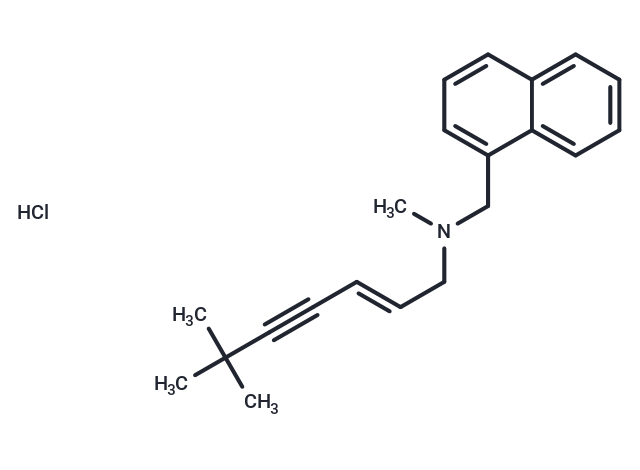Shopping Cart
- Remove All

Your shopping cart is currently empty


| Pack Size | Price | Availability | Quantity |
|---|---|---|---|
| 25 mg | $30 | In Stock | |
| 50 mg | $39 | In Stock | |
| 100 mg | $53 | In Stock | |
| 200 mg | $90 | In Stock | |
| 1 mL x 10 mM (in DMSO) | $57 | In Stock |
| Description | Terbinafine hydrochloride (KWD 2019) is a synthetic allylamine derivative structurally related to naftifine. Terbinafine is active against dermatophytes. |
| In vitro | Terbinafine (50 μM to 100 μM) inhibits only marginally the metabolism of ethoxycoumarin (CYP1A2), tolbutamide (CYP2C9), or ethynylestradiol, CsA, and cortisol. Terbinafine proves to be a potent inhibitor of the CYP2D6-mediated dextromethorphan O-demethylation and bufuralol 1-hydroxylation with IC50values of 0.2 μM and 0.25 μM, respectively. [1] Terbinafine is highly activ Aspergillus isolates (minimum inhibitory concentration [MIC] 0.01 to 2 mg/mL) with a primary fungicidal action (minimum fungicidal concentration [MFC] 0.02 to 4 mg/mL). [2] Terbinafine inhibits dextromethorphan O-demethylation with an apparent Ki ranging from 28 to 44 nM in human hepatic microsomes and averaging 22.4 nM for the heterologously expressed enzymes. [3] Terbinafine shows a very strong activity in vitro against Penicillium spp., Paecilomyces spp., Trichoderma spp., Acremonium spp. and Arthrographis spp. with GMs <1 mg/L. [4] Terbinafine decreases the levels of phosphorylated extracellular signal-regulated kinase (ERK). Terbinafine might cause a decrease of MEK, which in turn up-regulates p53 through the inhibition of ERK phosphorylation, and finally causes an increase of p21expression and cell-cycle arrest. [5] |
| In vivo | Terbinafine demonstrates efficacy both as a topical application and through oral administration in experimental dermatophytoses. Notably, in guinea pigs infected with fungi, a significant decrease in skin temperature is observed after the fourth terbinafine treatment[6]. |
| Alias | KWD 2019, Terbinafine HCl, TDT 067 hydrochloride |
| Molecular Weight | 327.89 |
| Formula | C21H26ClN |
| Cas No. | 78628-80-5 |
| Storage | Powder: -20°C for 3 years | In solvent: -80°C for 1 year | |||||||||||||||||||||||||||||||||||
| Solubility Information | DMSO: 50 mg/mL (152.49 mM), Sonication is recommended. | |||||||||||||||||||||||||||||||||||
Solution Preparation Table | ||||||||||||||||||||||||||||||||||||
DMSO
| ||||||||||||||||||||||||||||||||||||

Copyright © 2015-2024 TargetMol Chemicals Inc. All Rights Reserved.